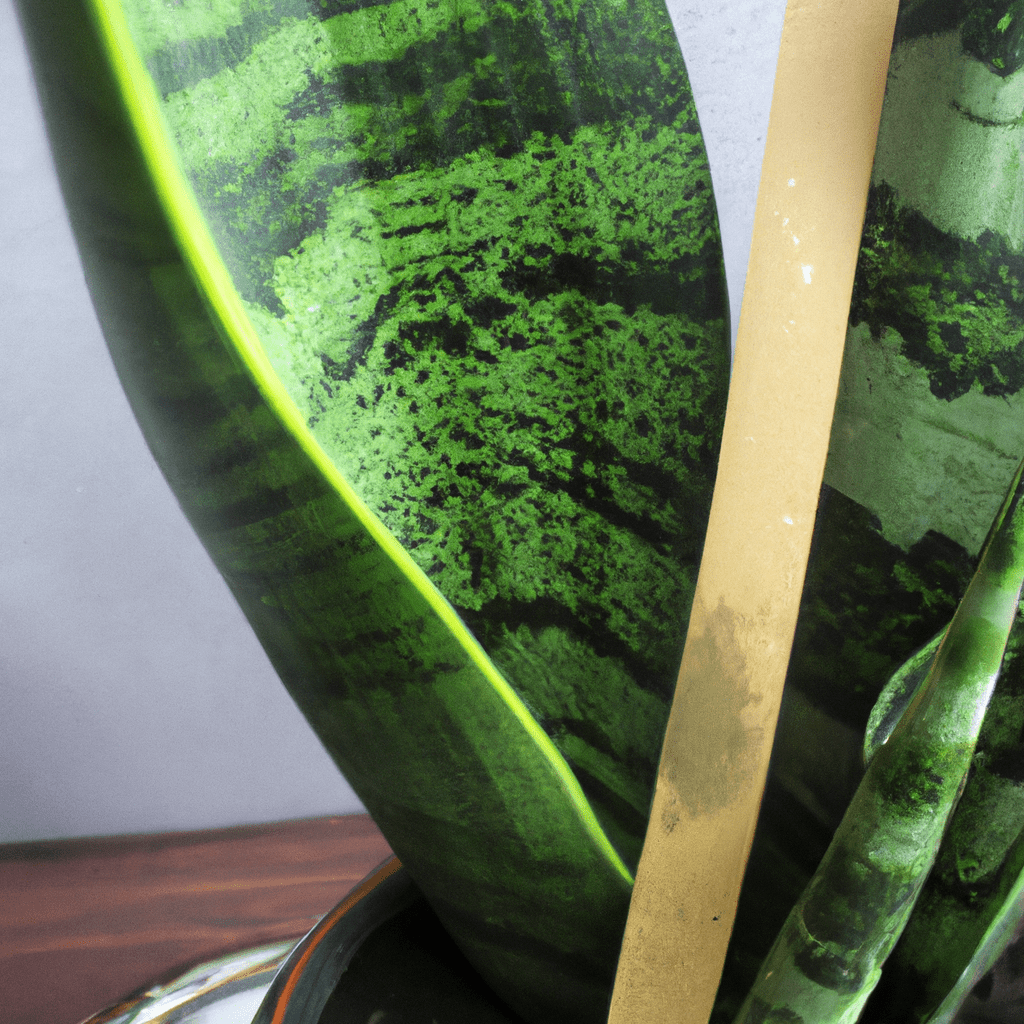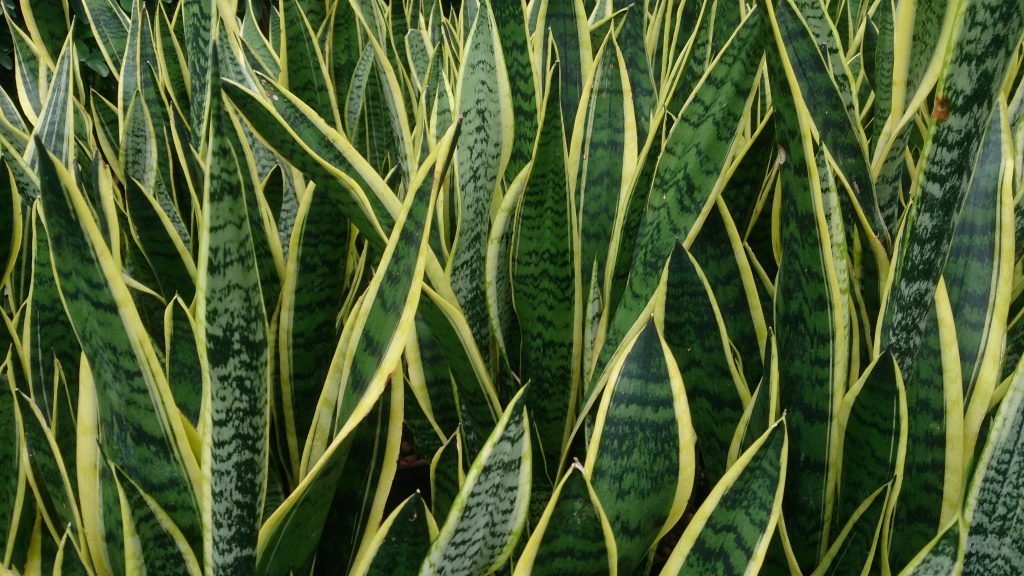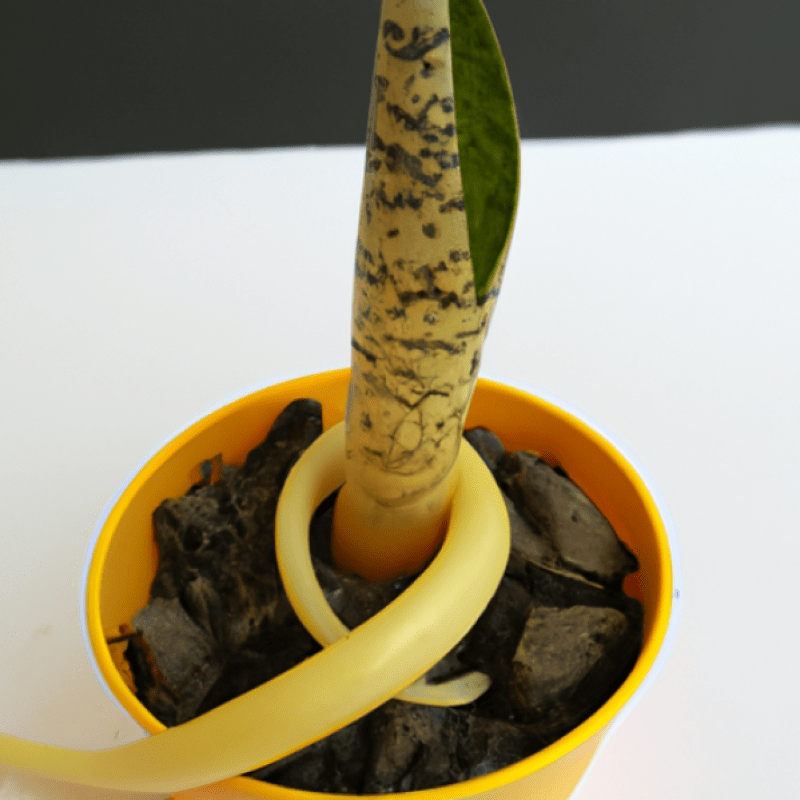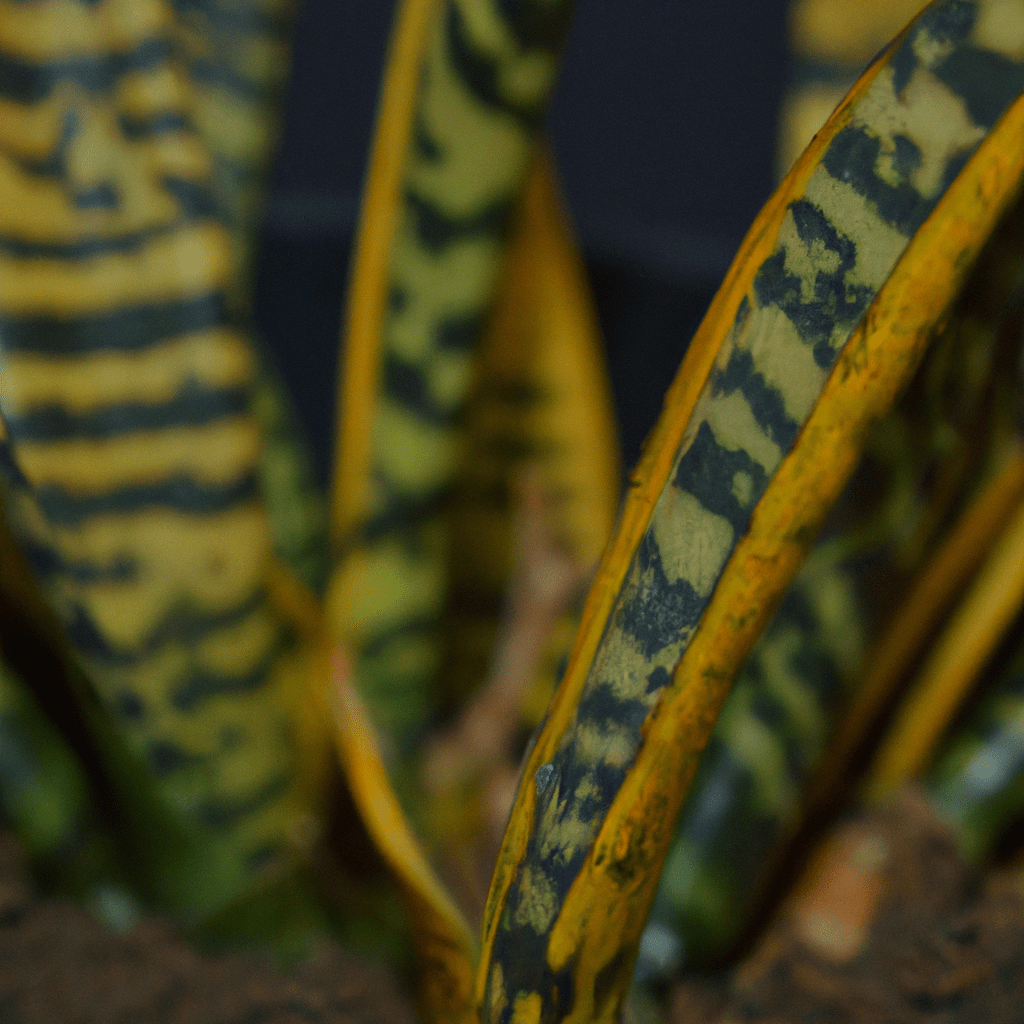Are you a plant lover who’s been searching for the perfect addition to your collection? Look no further than Sansevieria Masoniana – the ultimate statement plant that’s been standing tall in homes and offices for decades. This gorgeous species, commonly known as the whale fin or shark fin plant, requires minimal care and adds a touch of exotic flair wherever it’s placed. However, if you’re new to the world of Sansevieria Masoniana, you might be wondering how to keep your plant healthy and happy. Fear not – we’ve got you covered with 20 essential questions and answers on how to care for your Sansevieria Masoniana. Let’s dive in!
1. What is Sansevieria Masoniana?
Sansevieria Masoniana, also known as the Whale Fin or Shark’s Fin plant, is a unique species of snake plant that is native to West Africa. It is a slow-growing succulent that can reach up to two meters tall and has thick, upright leaves that resemble the shape of a whale’s fin. The leaves are a vibrant shade of green with dark green mottled stripes, and they grow in a rosette formation. Sansevieria Masoniana is highly sought after by collectors due to its distinctive appearance and unusual shape. It is easy to care for and can thrive in a variety of conditions, including low light and dry air.
2. Where should I place Sansevieria Masoniana in my home?
Sansevieria Masoniana is a unique plant with its large, paddle-shaped leaves that can grow up to three feet tall. It is a low maintenance houseplant that can thrive in a variety of lighting conditions, from bright indirect light to low light. However, it is important to avoid placing it in direct sunlight as it can scorch the leaves.
In terms of temperature, Sansevieria Masoniana prefers warmer temperatures between 60 to 85 degrees Fahrenheit and can tolerate lower temperatures down to 50 degrees Fahrenheit. It is also important to avoid placing it near cold drafts or air conditioning units. As for watering, Sansevieria Masoniana prefers to dry out between waterings and can go up to three weeks without water. When watering, it is important to water deeply and allow the excess water to drain out of the pot to avoid rot. Overall, Sansevieria Masoniana can make a great addition to any room in your home as long as it is given the proper lighting, temperature, and watering conditions.
3. How often should I water Sansevieria Masoniana?
Sansevieria Masoniana, also known as the Whale Fin or Shark Fin plant, is a hardy succulent that can tolerate drought. However, it is important to provide adequate water to keep the plant healthy. As a general rule, Sansevieria Masoniana should be watered once every 2-3 weeks during the growing season (spring and summer) and once a month during the dormant season (fall and winter). The frequency of watering will depend on factors such as the size of the plant, the humidity of the environment, and the amount of sunlight it receives. To prevent overwatering, it is important to allow the soil to dry out completely between waterings. When watering, thoroughly saturate the soil and allow any excess water to drain away. As with all plants, it is important to monitor the soil moisture levels and adjust the watering schedule accordingly.
4. Can Sansevieria Masoniana tolerate low light?
Sansevieria Masoniana, also known as “Whale Fin” or “Shark Fin” Sansevieria, is a relatively low-maintenance plant that can tolerate a range of light conditions, including low light. However, it is important to note that low light may cause the plant to grow more slowly and produce smaller leaves. Additionally, the variegation on the leaves may become less pronounced in low light conditions. It is recommended to place the Sansevieria Masoniana in bright, indirect light for optimal growth and leaf color. If the plant must be placed in a low light area, it is important to provide it with occasional exposure to brighter light to prevent the leaves from becoming too dark and to stimulate growth.
5. What kind of soil is best for Sansevieria Masoniana?
Sansevieria Masoniana thrives in well-draining soil with high organic matter content. The ideal soil for this plant should be slightly acidic with a pH range of 5.5 to 7.5. It is best to use a mix of peat moss, perlite, and sand in equal parts to ensure proper drainage and aeration. Additionally, adding a layer of gravel or rocks at the bottom of the pot can help with drainage. It is important to avoid using heavy clay soils or soils that retain too much water as they can lead to root rot and other problems. Regularly fertilizing the soil with a balanced fertilizer can also promote healthy growth and development of the plant.
6. What temperature range is suitable for Sansevieria Masoniana?
Sansevieria Masoniana, also known as Mason’s Congo or Whale fin, is a tropical plant that requires warm temperatures. The plant is sensitive to cold temperatures and should be kept in a warm environment. The ideal temperature range for Sansevieria Masoniana is between 60°F and 85°F. In colder temperatures, the plant may experience stunted growth, while higher temperatures can lead to dehydration and wilting. It is important to maintain a consistent temperature range to ensure the health and growth of the plant. Proper temperature control is essential for the Sansevieria Masoniana to thrive.
7. How often should I fertilize Sansevieria Masoniana?
Sansevieria Masoniana requires less fertilizing compared to most houseplants. You should only fertilize your plant during the growing season, which is from early spring to late summer. Over-fertilizing your plant can cause damage to the roots and leaves, so it is essential to be cautious. You can use a balanced liquid fertilizer, diluted to half strength, and apply it once every two months. Alternatively, you can use a slow-release fertilizer, which can be applied every four to six months. Ensure that you follow the manufacturer’s instructions and avoid applying fertilizer to dry soil, as this can cause root damage. Remember to flush the soil with water after fertilizing to avoid salt build-up.
8. What pests commonly attack Sansevieria Masoniana?
The Sansevieria Masoniana, commonly known as the Mason’s Congo or Whale Fin plant, is a popular houseplant that is generally low maintenance. However, it is not immune to pests. Some common pests that attack this plant include:
- Spider mites: These tiny pests are difficult to see with the naked eye and can cause damage to the leaves by sucking sap from them. Spider mites can be controlled with insecticidal soap or neem oil.
- Mealybugs: These white, cotton-like insects can cause damage by feeding on the plant sap and secreting honeydew, which can attract other pests like ants. Mealybugs can be controlled with insecticidal soap or rubbing alcohol.
- Scale insects: These small, round insects can cause yellowing and dropping of leaves by feeding on the plant sap. Scale insects can be controlled with insecticidal soap or neem oil.
It is important to regularly inspect your Sansevieria Masoniana for signs of pest infestation and treat them promptly to prevent damage to the plant.
9. Can Sansevieria Masoniana purify the air?
Sansevieria Masoniana, also known as the Whale Fin Snake Plant, has been touted as an effective air-purifying plant by some sources. However, there is a lack of scientific evidence to support this claim. While Sansevieria plants, in general, are known for their ability to remove toxins such as formaldehyde, benzene, and xylene from the air, the specific purifying capabilities of Sansevieria Masoniana have not been extensively studied. Additionally, the effectiveness of any air-purifying plant is dependent on several factors, such as the size of the space, the number of plants, and the level of air pollution. Therefore, while Sansevieria Masoniana may have some air-purifying qualities, it should not be relied upon as the sole means of improving indoor air quality.
10. How often should I repot Sansevieria Masoniana?
Sansevieria Masoniana generally requires repotting every two to three years. However, the frequency of repotting can vary depending on various factors such as the plant’s growth rate, pot size, and soil condition. It is advisable to check the roots and soil condition of the plant before repotting. If the roots are tightly coiled and there is no room for growth, or the soil is compacted and waterlogged, it is a sign that repotting is necessary. Additionally, repotting is best done during the growing season in spring or summer, as this allows the plant to recover quickly from the shock of repotting.
11. Will Sansevieria Masoniana grow in a small pot?
Sansevieria Masoniana, commonly known as the whale fin or shark fin plant, is a slow-growing species of snake plant that is known for its unique and attractive foliage. While it can adapt to a variety of growing conditions, including low light and neglect, it does have specific requirements when it comes to pot size. In general, Sansevieria Masoniana prefers to be slightly pot-bound, which means that it will thrive in smaller pots. However, if the pot is too small, it can become crowded and eventually stunt the plant’s growth. It is recommended to choose a pot that is just slightly larger than the plant’s root ball and to repot only when absolutely necessary. Additionally, it is important to ensure that the pot has good drainage to prevent waterlogged soil, which can lead to root rot.
12. How can I propagate Sansevieria Masoniana?
Sansevieria Masoniana can be propagated through leaf cuttings. The process involves selecting a healthy leaf and cutting it into several sections, each with a small piece of stem attached. The cuttings should be left to dry for a few days before being planted in well-draining soil. It is important to keep the soil moist but not waterlogged and to provide bright, indirect light. Propagation can also be done through division, where the parent plant is carefully removed from its pot and the roots and leaves are separated into smaller plants. This method should only be done with mature plants that have multiple shoots.
13. Is Sansevieria Masoniana toxic to pets?
Sansevieria Masoniana, also known as the Whale Fin Snake Plant, is considered to be mildly toxic to pets. The plant contains saponins, which can cause gastrointestinal upset, vomiting, and diarrhea if ingested by pets. While the toxicity level is relatively low, it is still important to keep Sansevieria Masoniana out of reach of pets and monitor them if they do come into contact with the plant. Signs of toxicity in pets may include excessive drooling, lethargy, and loss of appetite. If your pet exhibits any of these symptoms, it is important to seek veterinary care immediately.
14. Can Sansevieria Masoniana be grown outdoors?
Sansevieria Masoniana, also known as the whale fin or shark fin sansevieria, can be grown outdoors in certain climates. This plant prefers warmer temperatures, and is best suited for USDA zones 10-12. It can also thrive in partial shade or full sun, and has a moderate drought tolerance. However, it is important to note that this plant is sensitive to frost and should not be exposed to temperatures below 40 degrees Fahrenheit. Additionally, it is recommended to provide well-draining soil and to avoid over-watering, as this can cause root rot. Overall, Sansevieria Masoniana can be grown outdoors in specific conditions, but proper care and attention must be given to ensure its survival.
15. How tall can Sansevieria Masoniana grow?
The height of a Sansevieria Masoniana can vary depending on several factors such as environmental conditions, soil quality, and sunlight exposure. Typically, this plant can grow up to 3-4 feet tall, but under optimal conditions, it can reach heights of up to 6 feet. It is important to note that the growth rate of Sansevieria Masoniana is slow, and it may take several years to reach its full height potential. Proper care and maintenance, including regular watering and fertilization, can help promote healthy growth and development.
16. What are some common problems with Sansevieria Masoniana?
Sansevieria Masoniana, also known as the Whale Fin or Shark Fin plant, is a popular houseplant due to its unique appearance and low maintenance. However, like any plant, it can face certain problems that need attention. Some common issues with Sansevieria Masoniana are:
– Overwatering: This plant prefers well-draining soil and can’t tolerate standing water. Overwatering can lead to root rot and other fungal diseases, causing the leaves to turn yellow and mushy.
– Pest infestation: Mealybugs and spider mites are common pests that attack Sansevieria Masoniana. They suck the sap from the plant, causing leaves to become discolored and deformed. Regularly inspecting the plant and using insecticidal soap can help prevent infestations.
– Low light: Although this plant can tolerate a wide range of lighting conditions, low light can cause the leaves to become elongated and weak. Placing the plant in a bright spot or supplementing with artificial light can help maintain its compact growth and vibrant color.
Overall, with proper care and attention, Sansevieria Masoniana can thrive and make a great addition to any home or office.
17. How do I prune Sansevieria Masoniana?
To prune Sansevieria Masoniana, it is important to first identify any dead or damaged leaves and remove them at their base using clean, sharp pruning shears. Additionally, any leaves that are yellowing or showing signs of disease should also be removed. It is important to avoid over-pruning, as Sansevieria Masoniana is a slow-growing plant and removing too many leaves at once can stress the plant. Regularly removing dead or damaged leaves, however, can help promote healthy growth and prevent the spread of disease. It is also important to ensure that the pruning shears are clean and disinfected before and after use to prevent the spread of any potential diseases.
18. Can Sansevieria Masoniana grow in water?
Sansevieria Masoniana is a type of plant that is commonly referred to as the “whale fin.” While this plant is typically grown in soil, it is possible to grow it in water. However, it is important to note that growing Sansevieria Masoniana in water may not be the best option for this plant.
If you do decide to grow Sansevieria Masoniana in water, you will need to make sure that the roots are not completely submerged. This is because the roots need access to oxygen in order to survive. Additionally, it is important to change the water frequently to prevent the growth of bacteria that could harm the plant. Overall, while it is possible to grow Sansevieria Masoniana in water, it may not be the best option for this plant.
19. How can I increase humidity for Sansevieria Masoniana?
To increase humidity for Sansevieria Masoniana, you can try the following methods:
– Grouping: Grouping your plants together can help increase humidity levels as the moisture from the plants will accumulate and create a humid environment.
– Misting: Regularly misting your plants with water can increase humidity levels temporarily. However, be careful not to over-mist as this can lead to fungal growth.
– Peppering: Placing a layer of pebbles in a tray and filling it with water can create a humid environment as the water evaporates. You can also add a plant saucer or pebble tray underneath your Sansevieria Masoniana to increase humidity.
– Humidifier: Investing in a humidifier can be an effective method to increase humidity levels consistently. Place it near your plant and adjust the settings accordingly.
It’s important to note that Sansevieria Masoniana is a hardy plant and can tolerate lower humidity levels. However, increasing humidity levels can promote growth and keep the plant looking healthy and vibrant.
20. What are some unique features of Sansevieria Masoniana?
Sansevieria Masoniana is a unique plant that is commonly known as the whale fin or shark fin. It is a very interesting plant that has some unique features, including its size and shape. The broad leaves of the plant are shaped like a whale’s fin, and they can grow up to 2 feet long. One of the most unique features of the plant is its color. The leaves are a deep, dark green with light green markings that look like waves. Additionally, the Sansevieria Masoniana is very hardy and can tolerate a wide range of growing conditions, making it an excellent choice for beginning gardeners. The plant is also low maintenance and requires very little watering and fertilization. Overall, the Sansevieria Masoniana is a fascinating plant that is sure to be a conversation starter in any garden or home.
So there you have it, folks! You are now a Sansevieria Masoniana expert. You know how to care for it, what to do when things go wrong, and even how to propagate it. Whether you’re a succulent enthusiast or just looking for a low-maintenance plant to brighten up your space, Sansevieria Masoniana is a fantastic choice. So go ahead and give it a try – your green thumb will thank you! And remember, if you ever have any questions or concerns, don’t be afraid to ask your local plant expert or consult the trusty internet. Happy planting!



